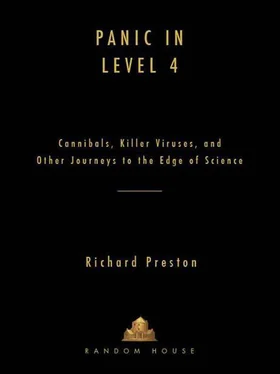We know that Ebola virus was one of the more powerful bioweapons in the arsenal of the old Soviet Union. In the years before the Soviet Union broke up, in 1991, bioweaponeers had reportedly been experimenting with aerosol Ebola—powdered, weaponized Ebola that could be dispersed through the air, over a city, for example. The Soviet weaponized Ebola was apparently stable enough that it could drift for distances in the air and still infect people through the lungs when they breathed a few particles of it. This is why the U.S. Army was studying it: the Army researchers were trying to come up with a vaccine or a drug treatment for Ebola, in case of a terrorist or military attack on the United States with Ebola.
As a natural disease, Ebola virus does not seem to be able to pass from person to person through the air, though. In each of the natural Ebola outbreaks, the disease seems to burn itself out, and Ebola fades away and is lost in the backdrop of nature, until, once again, by chance, it finds its way into a human host.
* * *
ONE DAY I WAS INTERVIEWING the commander of Fort Detrick. We were getting toward the end of the interview, and I decided to ask one last question. “I’d like to try to convey to readers what it really feels like to be face-to-face with Ebola virus.” I said. “Could I go into Level 4?”
“That should be no problem,” the commander answered promptly. “We’ll get you outfitted in a blue suit,” he said, “and walk you through Suite AA-4”—one of the Ebola hot zones. “It’s down and cold,” he added.
“What do you mean by ‘down and cold’?” I asked.
He explained that the hot zone had been completely sterilized with gas and opened up for routine maintenance. The rooms weren’t dangerous. Anyone could go into the lab without wearing a space suit. The hot freezers, too, had been moved out of the lab. Therefore, the lab was completely cold and safe.
“That’s not really what I had in mind,” I said.
“What did you have in mind?” he asked.
“I would like to experience the real thing, so that I can describe it. I’d like to go into a hot BL-4 lab and see how the scientists work with real Ebola.”
“That’s not possible,” he answered immediately.
Security at USAMRIID was extremely tight. Even so, it was not as tight as it would become. That day in the commander’s office was some nine years before the anthrax terror attacks of the autumn of 2001, shortly after 9/11. The anthrax attacks came to be known as the Amerithrax terror event, after the FBI’s name for the case. Small quantities of pure, powdered spores of anthrax—a natural bacterium that has been developed into a very powerful bioweapon—were placed in envelopes and mailed to several media organizations and to the offices of two United States senators. Five people died after inhaling the spores, while others became critically ill; some of the survivors have never fully recovered. For the most part the victims, including African-Americans and recent immigrants to the United States, were low-level employees of the post office who were just doing their jobs. No one has been charged with the Amerithrax crimes. The evidence suggests they were done by a serial killer or killers who intended to murder people and may have taken pleasure in causing the deaths while escaping punishment. The case remains open.
Officials at the United States Department of Justice named Steven Jay Hatfill, a former researcher at USAMRIID, as a “person of interest” in the case. Hatfill has never been charged with involvement in the crimes, though. At the same time, there was speculation in the news media that the exact strain of anthrax used in the attacks might have come out of an Army lab, even possibly from USAMRIID itself, where defensive medical research in anthrax had been going on for years. (The precise results of the FBI’s analysis of the anthrax strain have not been disclosed by the government, as of this writing.) USAMRIID scientists, in fact, played a key role in the forensic analysis of the anthrax that was collected from the envelopes.
Following the Amerithrax terror event, security at USAMRIID became astronomically tight. After that, it would have been useless for a journalist to ask to go into the space-suit labs. Back at the time when I was researching The Hot Zone, though, there was a slight amount of flexibility in the policy. On certain occasions, the Army had allowed untrained or inexperienced visitors to go into hot zones at USAMRIID. Unfortunately, as the commander explained to me, some of these visits had ended badly. People who were not familiar with space-suit work with hot agents had a tendency to panic in Level 4, he said.
In one such an incident, a medical doctor—a visitor—who had apparently never worn a biohazard space suit attended a human autopsy in a Level 4 morgue at the Institute. This hot morgue is called the Submarine. The Submarine is a sealed hot zone with an autopsy room and an autopsy table. The cadaver was believed to be infected with a Level 4 Unknown X virus. During the examination, while the space-suited autopsy team was removing organs from the cadaver, some members of the team noticed that the visiting doctor’s face seemed red. As the team members looked at him through his faceplate, they saw that his face was also dripping with sweat. Meanwhile, the outer surfaces of his space-suit gloves and sleeves were smeared with blood from the cadaver.
Reportedly, the man began saying, “Get me out!” Suddenly he tore off his helmet and ripped open his space suit, gasping for breath, taking in lungfuls of air from the hot morgue.
The members of the autopsy team took hold of him and hurried him to an air lock door leading to the exit. They opened the door, pushed him into the air lock. At least one of the team members accompanied him into the air lock. The air lock was closed, and the chemical shower was started.
The way I heard the story, the man stood or sat in the air lock while the chemicals ran down inside his opened space suit. The shower stopped automatically after seven minutes. The chemicals had flooded his suit. Then the team members helped him into the staging area—the so-called Level 3 area—and helped pull him out of his space suit. By this time, he was subdued and embarrassed.

The United States Army Medical Research Institute of Infectious Disesases (USAMRIID)
Getty Images
At USAMRIID, people who have had a verified exposure to a hot agent are put into a Level 4 quarantine hospital suite called the Slammer. The Slammer is a biocontainment unit where doctors and nurses wearing space suits can treat a patient without being exposed to a virus the patient may have. The man who had panicked was a possible candidate for quarantine in the Slammer. Even so, after an immediate review of the incident by a safety team, the Army felt that he did not need to be put in quarantine; there was no evidence that the cadaver had actually been infected with a virus. And the man never got sick.
“We can’t predict how someone who’s untrained might react in BL-4, so we can’t allow you to go in,” the commander explained to me.
I still wanted to go into Level 4. But I couldn’t see how to get there.
* * *
IN NARRATIVE NONFICTION WRITING, taking notes is an essential part of the creative process. We tend to think of a reporter’s notes as being a transcript of the words of someone speaking to the reporter. If you who are reading this happen to be a student of journalism, remember that you can take notes about anything. It can be quite useful to jot down observations on any and all details of a person and a scene, including sights, smells, and sounds, as well as the emotional aura of the scene. These kinds of observed details might be called deep notes. Deep notes are a record of the visceral reality in which the characters exist—notes on the soup. Deep notes can be details of how people move their bodies, what they wear, what sorts of tics and gestures they display. I always try to note the color of a person’s eyes, and, when possible, I try to observe their hands.
Читать дальше









![Shin_Stark - В подземелье я пойду, там свой level подниму X [СИ]](/books/384602/shin-stark-v-podzemele-ya-pojdu-tam-svoj-level-po-thumb.webp)



